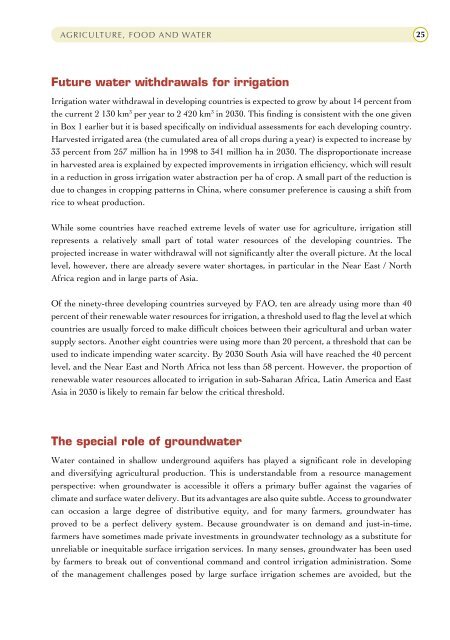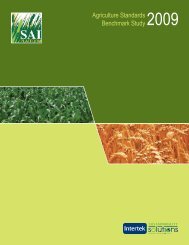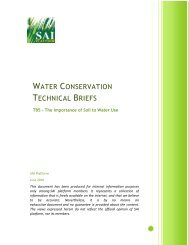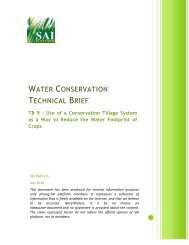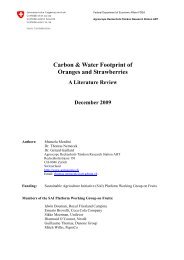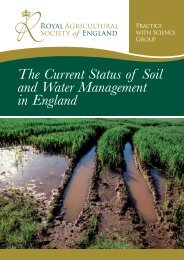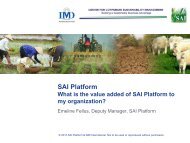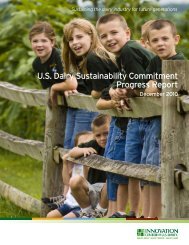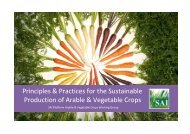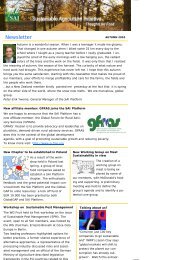Agriculture, food and water - FAO.org
Agriculture, food and water - FAO.org
Agriculture, food and water - FAO.org
You also want an ePaper? Increase the reach of your titles
YUMPU automatically turns print PDFs into web optimized ePapers that Google loves.
AGRICULTURE, FOOD AND WATER<br />
25<br />
Future <strong>water</strong> withdrawals for irrigation<br />
Irrigation <strong>water</strong> withdrawal in developing countries is expected to grow by about 14 percent from<br />
the current 2 130 km 3 per year to 2 420 km 3 in 2030. This finding is consistent with the one given<br />
in Box 1 earlier but it is based specifically on individual assessments for each developing country.<br />
Harvested irrigated area (the cumulated area of all crops during a year) is expected to increase by<br />
33 percent from 257 million ha in 1998 to 341 million ha in 2030. The disproportionate increase<br />
in harvested area is explained by expected improvements in irrigation efficiency, which will result<br />
in a reduction in gross irrigation <strong>water</strong> abstraction per ha of crop. A small part of the reduction is<br />
due to changes in cropping patterns in China, where consumer preference is causing a shift from<br />
rice to wheat production.<br />
While some countries have reached extreme levels of <strong>water</strong> use for agriculture, irrigation still<br />
represents a relatively small part of total <strong>water</strong> resources of the developing countries. The<br />
projected increase in <strong>water</strong> withdrawal will not significantly alter the overall picture. At the local<br />
level, however, there are already severe <strong>water</strong> shortages, in particular in the Near East / North<br />
Africa region <strong>and</strong> in large parts of Asia.<br />
Of the ninety-three developing countries surveyed by <strong>FAO</strong>, ten are already using more than 40<br />
percent of their renewable <strong>water</strong> resources for irrigation, a threshold used to flag the level at which<br />
countries are usually forced to make difficult choices between their agricultural <strong>and</strong> urban <strong>water</strong><br />
supply sectors. Another eight countries were using more than 20 percent, a threshold that can be<br />
used to indicate impending <strong>water</strong> scarcity. By 2030 South Asia will have reached the 40 percent<br />
level, <strong>and</strong> the Near East <strong>and</strong> North Africa not less than 58 percent. However, the proportion of<br />
renewable <strong>water</strong> resources allocated to irrigation in sub-Saharan Africa, Latin America <strong>and</strong> East<br />
Asia in 2030 is likely to remain far below the critical threshold.<br />
The special role of ground<strong>water</strong><br />
Water contained in shallow underground aquifers has played a significant role in developing<br />
<strong>and</strong> diversifying agricultural production. This is underst<strong>and</strong>able from a resource management<br />
perspective: when ground<strong>water</strong> is accessible it offers a primary buffer against the vagaries of<br />
climate <strong>and</strong> surface <strong>water</strong> delivery. But its advantages are also quite subtle. Access to ground<strong>water</strong><br />
can occasion a large degree of distributive equity, <strong>and</strong> for many farmers, ground<strong>water</strong> has<br />
proved to be a perfect delivery system. Because ground<strong>water</strong> is on dem<strong>and</strong> <strong>and</strong> just-in-time,<br />
farmers have sometimes made private investments in ground<strong>water</strong> technology as a substitute for<br />
unreliable or inequitable surface irrigation services. In many senses, ground<strong>water</strong> has been used<br />
by farmers to break out of conventional comm<strong>and</strong> <strong>and</strong> control irrigation administration. Some<br />
of the management challenges posed by large surface irrigation schemes are avoided, but the


